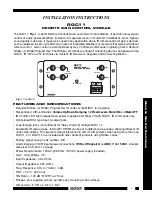
CPCI-824 User’s Manual
A-1
Revision 1.0, January 2006
APPENDIX A
PMC MODULE INTERFACE
A.1
INTRODUCTION
The PMC Module Interface allows PCI devices to be connected to the Local PCI interface of the CPCI-
824 host. The IEEE STD P1386.1, PCI Mezzanine Card (PMC), provides for one set of clocking and
arbitration signals per PMC Module. Cyclone Microsystems has expanded this to two sets per PMC
Module on the CPCI-824. With ability to connect a PMC module on the CPCI-824, up to two devices
are supported. Otherwise, with a few exceptions, the standard signals defined for 64-bit CPCI
connectors are used for the PMC Modules. The exceptions are noted in Section A.3. The timing for
devices on PMC Modules is the same as the timing for any other PCI device; see the
PCI Local Bus
Specification
revision 2.2 for details. The CPCI-824 PMC module location is defined as +3.3V
signalling. Note that only +3.3V or universal signalling PMC modules may be used on the CPCI-824.
A number of PMC Modules are available from Cyclone Microsystems. This section is intended for
users interested in developing their own modules.
A.2
PHYSICAL ATTRIBUTES
Please refer to IEEE P1386/Draft 2.0 for the physical dimensions of PMC modules.
A.3
PMC MODULE SIGNAL DEFINITIONS
PMC Modules use the signals defined in the IEEE STD P1386.1. The following four signals are added
to this definition to handle the expansion from one to two devices per PMC module:
•
GNT1#
•
REQ1#
•
CLK1
•
IDSEL1
Please note that the added signals used the PMC-RSVD signals as defined in IEEE STD P1386.1. The
PCI-RSVD remain untouched.
Also, note that GNT1# follows the description for GNT#, REQ1# follows the description for REQ#,
CLK1 follows the description for CLK, and IDSEL1 follows the description for IDSEL. When the
appropriate signals are connected to PCI devices on a PMC Module, each device has the full
complement of PCI signals defined in the specification.
IDSEL signals are not provided. The designer of a PMC Module should connect the proper AD signal to
a device’s IDSEL pin. AD21:16 may be used depending on the desired number mapping scheme. The
suggested signal connections are shown in tables A-1 and A-2.






































